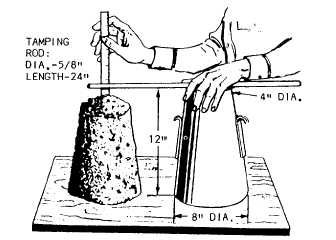MOBILE CONCRETE MIXER
PLANT
The trailer-mounted mobile concrete mixer plant
(fig. 7-2) carries cement, sand, and coarse aggregates in
divided bins mounted on the unit. The cement is carried
in a separate bin located across the rear of the unit, and
the sand and aggregate are carried on each side of the
unit. Water is carried in a single tank mounted in front
of the aggregate bins and is pumped to the mix auger.
Sand and aggregates are accurately proportioned by
weight or volume and simultaniously dropped with a
mixture of cement from the material feed system into
the charging end of the mix auger/conveyor at the rear
of the unit. At this point, a predetermined amount of
water enters the mix auger. The action of this combined
auger and paddle homogenizer mixes the ingredients
and water rapidly, thoroughly, and continuously to
produce a continuous flow of uniformed quality
concrete. The material mixing action is a continuous
process that can proceed until the aggregate bins are
empty. On the other hand, mixing and delivery may be
stopped at any time and then started again at the will of
the operator. This permits production to be balanced to
the demands of the placing and finishing crews and other
job requirements.
Operators assigned to the “crete mobile” must
thoroughly read and understand the technical manual
before operating the plant.
The following are the mobile concrete mixer plant
cautions and warnings:
Follow all preventivc maintenance procedures.
Do not allow any foreign matter in the cement
bin.
Do not allow paricles larger than 1 1/2 inch in
the aggregate bin.
Do not allow the waterlines and flowmeters to
freeze with water in them.
Do not run the water pump dry.
Do not continue to operate the machine if the
hydraulic oil temperature exceeds 190°F.
Wash out the auger within 20 minutes of the last
use.
l
l
l
l
l
l
Never attempt to repair the machine while in
operation (always turn the power source
off).
Keep your entire body clear from all moving
parts.
Never attempt to walk on top of the aggregate bin
to cross from the cement bin to the water tank
(use the ladder).
Never walk or stand under the auger.
Never climb inside the aggregate bin (use a small
pole to dislodge any aggregate that has
bridged).
Never enter the cement bin while in operation
(there are moving parts inside the bin). -
SLUMP TEST
The slump test is used to measure the consistency
of a concrete mix. The test is normally performed by an
Engineering Aid (EA) and is made by using a slump
cone. The cone is 12 inches high with an
8-inch-diameter base and a 4-inch-diameter top (fig.
7-3).
A bucket is filled with a sample of the concrete from
the discharge chute from the mixer. From this sample,
the cone is filled in three layers. Each layer should
contain approximately one third of the volume of the
cone. Each layer is rodded in the cone with 25 strokes
from a 5/8-inch-diameter tamping rod 24 inches long.
The strokes should be distributed uniformly over the
cross section of the cone and should penetrate into the
underlying layer. The bottom layer should be rodded
Never attempt to operate the unit while in motion.
Figure 7-3.-Measurement of slumps.
7-7


